#kata kane
Text

LEARN MANGA-INSPIRED ART with me this Saturday 2/17! I’m returning to my college town to host an art seminar at the Westminster branch of CCPL. we’re going to chat, draw, and make zines together! 💖✂️
#westminster#maryland#Carroll county#public libraries#free Art workshop#kata kane#GFFs ghost friends forever
2 notes
·
View notes
Photo





the 100 fandom rewatch // 2.06 “Fog of War”
we all have battle scars. suck it up and build a brace for yours
#the 100#the100edit#t100edit#the100rewatch#lexa kom trikru#marcus kane#thelonious jaha#**katas#100fanwatch*#kane is so angy in that first gif lmao
134 notes
·
View notes
Text
Breath Of The Wild Theme
names for characters from the legend of zelda; breath of the wild!
ak, akk, akka, akkal, akkala,
aya,
au, aug,
al, ali, aliz, aliza,
ash, ashe,
ax, axy, axyl,
aj, aji,
akra, akrah,
achne,
ardin,
ashai,
aurie,
ariane,
amali,
ami,
agus,
amira,
aster
azu,
armes,
anly,
bad, badd, baddek,
bam, bamb, bambo, bamboo,
ban, banji,
bau, baum, bauma, baumar,
bay, bayg, bayge,
bee, beed, beedle,
bol, bols, bolson,
bri, brig, brigo,
bai, baij,
ben, benn, benny,
bo, bosh,
bot, botr, bore, botri, botric, botrick,
bran, branli,
blad, bladon
boh, bohr, bohri, bohrin,
bold, boldon,
bree, breen,
bar, barg, bargo, bargoh,
blu, blud, bludo,
blynne,
barta,
benja,
babi
bertri,
bozai,
bulia, buliara,
bedoli,
bazz,
brokka,
bugut,
cam, camb, cambo,
chab, chabi,
cho, chor, chork,
chu, chum, chumi, chumin,
chi, chiga,
cal, cala, calam, calami, calamity,
can, cann, canni,
chuk, chuki,
chio,
calisa,
caly, calyban,
cara,
canolo,
cree,
cecili,
cleff,
celessa,
calip,
clavia,
chessica,
cloyne,
cima,
cotera,
cado,
claree,
cottla,
dab, dabi,
da, dah,
dmi, dmit, dmitr, dmitre, dmitri,
dai, daim,
drak,
dug, dugby,
damia,
daz,
dillie,
dalia,
danda,
deltan,
dina,
dorrah,
danton,
dento,
dunma,
dorephan,
dantz,
darton,
domidak,
dorian,
en, end, enda, endai,
ep, epo, epon, epona,
et, ets, etsu,
el, eld, eldi, eldin,
essa,
estan,
emry,
eryck,
far, faro, faroh, farosh,
fy, fys, fyso, fyson,
fi, fin, finn,
fu, fugo,
faron,
fegran,
frelly,
frita,
furosa,
flaxel,
falmark,
finley,
fronk,
flavi,
gof, gofla, goflam,
grey, greyson, gray, grayson
glee, gleem, gleema,
gran, grant, grante,
glen, glend, glendo,
gan, gano, ganon,
got, gott, gottr, gottre, gotter,
gom, goma, gomar,
gai, gail, gaile, gale,
gon, gong, gongur, gonguro, gonguron,
gor, gora, gorae,
grap, grapp,
goro, goron,
gar, gars, garsh, garshon,
gartan,
greta,
guy,
galli,
geggle,
genli,
gesane,
gruve,
gaddison,
garill,
garini,
giro,
hy, hyr, hyre, hyru, hyrule,
hyl, hyle, hyli, hylia, hylian,
hee, heehl,
hes, hest, hestu,
hud, huds, hudso, hudson,
hesh, hesho,
hag, hagi, hagie,
hun, hunn, hunni, hunnie,
hoz,
hai, hait, haite,
hal, halan,
harlow,
harry,
harth,
huck,
hino,
ita,
isha,
izra,
ivee,
impa,
jan, jana, janna,
jer, jeri, jerr, jerri, jerrin,
ja,
jen, jengo,
jini,
jora,
jules,
juan, juanne, juanne, juannelle,
jogo,
juney,
jiahto,
joute,
kab, kabe, kabet, kabett, kabette, kabetta,
kan, kann, kanny,
kap, kaps, kapso, kapson,
kar, karso, karson,
kas, kass,
ken, keny, kenyo,
ki, kil, kilt, kilto, kilton,
ka, kah,
kai, kaif, kaifa,
ke, ke'nai,
kash, kasho,
kat, kato, katos, katosa,
khi, khin, khini,
kin, king,
ko, kor, kori, korima,
keh,
korb, korba, korbah,
kal, kala,
kaso,
kaa, kaam,
kata, katah,
katt, katta,
kon, konba,
kair, kairo,
karsh,
kay, kayr, kayre, kayra,
kim, kima,
kish,
krane,
ketoh,
korok,
kula,
konora,
kyra,
kalani,
kohm,
kotta,
kachoo,
kaysa,
kheel,
kotts,
kaneli,
kayden,
keye,
kodah,
karin,
koyin,
kiana,
kinov,
kampo,
koko,
li, lin, link,
lee, leek, leeka, leekah,
lar, laro, larob, laroba,
lon, lonn, lonni, lonnie,
lat, lata, latan,
loone,
lukan,
laine,
lashley
leena,
liana,
lorn
lyn, lynd, lyndae,
lester,
laissa,
ledo,
laflat,
laruta,
lawdon,
letty,
leop,
lasli,
me, mee, meesh, meeshy,
meg, megh, meghen, meghan, meghyn,
mei,
mil, mils,
mi, min, mina,
miph, mipha,
mis, misk, misko,
mae, mael,
mog, mogg, moggs,
mo, mon, mona, monar, monari,
mony, monya,
my, myt, myti,
mij, mija, mijah,
may, mayr, mayro,
mir, mirr, mirro,
molo,
maca,
mala, malanya,
makure
malena,
marta,
merina,
muava,
maike,
maypin,
moza,
mary,
monkton,
modar,
molli,
mazli,
misa,
marot,
muzu,
mimos,
manny
medda,
mubs,
mimo,
magda,
mellie,
nat,
nay, nayd, naydr, nadre, naydre, nadra, naydra,
naz, nazbi,
nad, nadd, naddo, naddon,
neil,
ni, nim, nima,
nobo,
nam, namu, namut,
nami, namik, namika,
noy, noya,
neha,
natie,
nali,
nellie,
nobiro,
nott, notts,
nekk,
nack,
narah,
nebb,
nikki,
numar,
nanna,
om, oma, oman,
owa,
oz, ozz,
ooh,
offra, offrak,
ozu, ozun, ozund, ozunda,
oak, oaky, oaki,
onya,
olu,
oliff,
olkin,
ollie,
pel, peli, pelis, peliso, pelison,
pi, pika, pikan, pikang, pikango,
pit, pita, pitar,
plat, plate, platea, plateau,
par, parc, parce, parcy, percy,
py, pyle,
peeks,
pepp,
padok,
perosa,
phanna,
pokki,
padda,
pasha,
pearle,
ploka,
pritana,
pyra,
palme,
piaffe,
pirou,
pondo,
ponthos,
pedra,
prima,
pruce,
purah,
prissen,
paya,
qua,
quince,
reg, rega, regan,
rev, reva, reval, revali,
rho, rhon, rhond, rhonds, rhondso, rhondson,
ri, rik,
ron, ronn,
rex,
ru, rul, ruli,
rob, robb, robbi, robbie,
rudi,
rhoa, rhoam,
roh, roht, rohta,
ruv, ruvo,
rot, rota,
rok, roke, rokee,
ray, raym,
russ,
ram, rame, ramel, ramell, ramella,
ro, rog, roga, rogar, rogaro,
roha, rohan,
roscoe,
riju,
reez, reeza,
rima,
risa,
roma, romah,
rotana,
ripp,
ropsten,
raegah,
rivan,
ralera,
reede,
rhodes,
rozel,
rensa,
rola,
sav, save, savel, savell, savelle,
sher, sherf, sherfi, sherif, sherfin,
sho,
sor, sorel, sorrel, soreli, sorelia,
spoon, spoone,
si, sido, sidon,
shaka, shakah,
stam, stamm,
sea,
saas,
shi, shir, shira,
sham, shama, shamae,
shor, shore, shora,
shae,
spri, sprinn,
straia,
suzum suzuna,
shabonne,
strade,
sud, sudrey,
saula,
smaude,
spera
sumati,
shaillu,
sesami,
selmie,
saki,
seggin,
satty,
spinch,
sayge,
sefaro,
seldon,
sophie,
senna,
symin,
sebasto,
sagessa,
shay,
shibo,
steen,
tor, torr, tore, toren,
tot, tots, totsu, totsun, totsune, totsuna,
ty, tye,
ten, tenn, tenne,
tu, tut, tuts, tutsu, tutsuwa,
tar, tarr, tarry, tarre, tarrey,
tom, toma,
tof, toff, toffa,
tro, trot, trott,
toh,
tan, tank, tanko,
tray,
tash, tasho,
tali,
tera,
tauma,
teake,
traysi,
teba,
tulin,
tona,
tottika,
tula,
torfeau,
trello,
tumbo,
teli,
tamana,
teebo,
thad,
tokk,
tasseren,
trissa,
urb, urbo, urbos, urbosa,
uma,
vol, volc, volco, volcon,
villa,
varke,
verla,
walton,
wabbin,
worten,
yam, yamm, yammo,
yo, yow, yowa, yowak, yowaka,
yahsa,
yu, yun, yuno, yunobo,
yaido,
yolero,
ze, zel, zeld, zelda,
zy, zyl, zyle,
zu, zum, zumo,
zuna,
zal, zalt, zalta,
zo, zor, zoro, zoron, zorona,
zooki,
zumi,
zuta.
list
#breath of the wild#zelda breath of the wild#botw#botw characters#zelda names#botw names#name searching#name blog#names#name list#name finder#name hoarder#name help#nicknames#list of names#listing names#themed names#names from characters#character names#botw character names#names list#name inspo#name ideas#name inspiration#names ideas#baby names
32 notes
·
View notes
Text
Maeda Kentaro - Interview with Terakoya Plus by Ameba
(Since I’m too sick to translate the whole interview, I’m gonna make a brief from it).
Just rough translation so forgive me for any mistakes.

Well, first things first, some info about the movie:
- The director of the movie is Mr. Koichi Sakamoto, who’s famous for action scenes, so there’s gonna be a bunch of pre-henshin actions.
- FYI: The antagonist of the movie is played by Mr. Kane Kosugi, a martial artist and actor (He also played NinjaBlack in Kakuranger). I’m looking forward to seeing the fighting scenes between him and Kentaro.
Now, stuffs from the interview:
- Kamen Rider Revice is Maeda Kentaro’s first full-ledged film, so he didn’t expect to have many people at the filming location.
- As you might know, he won the national championship in kata team competition. Since his name has the word “fist” (拳), many people misunderstood that his house is a dojo. But in fact, when he’s in kindergarten, his friend started practicing karate so he wanted to do so.
- When he’s in primary school, he didn’t like karate that much. He took a liking to it when he was in junior high school and aimed to be the best in Japan.
That’s why on holidays, he would get up around 5:00 in the morning, go for a run, and practice all day until night. During long holidays, he would go to training camps. The only time he had a day off was about a week before the competition.
So when he was in high school, that habit made him sick before the competition and he didn’t have good results, he was so disappointed with himself.
At that time, he got a keychain from a friend in the dojo, saying "Continuation is power”. That helps him realized how important and valuable everything he had been doing was. And his passion for karate grew even stronger.
Even though he didn’t get as good results as he did when he’s in junior high, he ate lunch during the short third period break and used the long lunch break time to practice with his friends, and just focused on karate.
In his dojo, there’s a boy who competed in international competitions and Kentaro was really desperate to catch up with him. But he was aware that no matter how hard he tried, he couldn't close the distance between them...
But he realized his lack of athleticism in karate had enabled him to do other sports, that’s when he wanted to try something else.
- His childhood dream is to be a Kamen Rider and an actor, so when he graduated from high school, he took part in the Junon Boys Competition, but he didn’t get a good result.
- He wondered that he wasn’t cut out for acting, so he went to a private university thinking that he would experience many things and maybe try again.
- He took part in (it’s more like being forced to join lol) the competitive dance club since he wanted to do something that he could be serious about and he took a liking to ballroom dancing.
- When Corona happened, he spent a whole year thinking about his life and his desire to be an actor. Then he quitted the club and began attending the acting course at his current agency, LDH's EXPG STUDIO, as a training candidate.
- He thought he had failed the last round of the Kamen Rider audition, so he’s surprised to know that he would play the leading role.
- The compliments Kentaro received more frequently were “Your posture is good” and “You are so polite” (lmao). (He’s even told that he’s too nice that he couldn’t give birth to a devil lol).
15 notes
·
View notes
Text
Hai? Apa kabar hari ini?
Pertanyaan yang membosankan ya?
Tapi ternyata, pertanyaan yang biasa seperti ini sangat berarti bagiku kini. Jangankan bertanya dan mengetahui kabarmu hari ini, sekadar menyapa saja rasanya tidak bisa. Jauh... kamu jauh.
Masih teringat dan terasa sangat jelas, hangatnya sapaanmu di dinginnya pagi yang menusuk. Menyapa dengan senyuman indah yang kini ku rindukan.
Saat itu, kamu datang di waktu yang tidak pernah kuduga, mencoba memasuki hidupku dengan segenap usaha dan tenaga yang kamu punya, lalu dengan bodohnya aku percaya begitu saja.
Masih teringat jelas, hari dimana kamu ulurkan tangan itu diiringi manisnya ucapanmu tentang angan mengenai kamu&aku; kita, di masa depan. Kini, dimana masa depan itu? Helaan nafasku saat menulis ini mengiringi satu pikir, "jangankan masa depan, mengenai aku & kamu saja apa masih layak untuk ku bubuhi kata 'kita' di sampingnya?". Jawabannya pasti tidak, ya?
Sakit. Ternyata sakit rasanya, di saat kamu memintaku untuk meninggalkan lingkaran kelam itu tetapi di saat yang bersamaan kamu sendiri yang membuatku jatuh semakin dalam. Bodoh, bodoh sekali rasanya mengingat bahwaku mempercayai semua yang kamu katakan. Coba dengar, kamu ingat tidak dengan perkataan ini, "kamu boleh bergantung padaku, tidak apa." atau "aku sayang kamu". Tidak ingat, ya?
Jahat, ternyata jahat sekali kata-kata manis yang kamu ucap dari mulutmu itu. Bohong, semuanya hanya omong kosong. Nyatanya kamu sama, hanya berlalu lalang di kehidupanku layaknya pemain peran yang melontarkan semua omong kosong.
Kini, dimana kamu? Kembali padanya ya?
Kalau begitu, selamat! kamu berhasil. Jika tujuan awalmu hanya untuk menghancurkanku, kamu berhasil.
— s, 16.07.22
3 notes
·
View notes
Text

Jakarta (ANTARA) - Penyerang Arsenal Bukayo Saka mengundurkan diri dari skuad tim nasional Inggris, menjelang pertandingan-pertandingan persahabatan melawan Brazil dan Belgia.
Saka merupakan salah satu sosok kunci dalam timnas Inggris asuhan Gareth Southgate namun akan absen pada pertandingan-pertandingan pemanasan Piala Eropa 2024 akibat cedera yang tidak dijelaskan.
Pertandingan melawan Brazil di Wembley pada Sabtu (23/3) dan menghadapi Belgia di tempat yang sama pada Selasa (26/3) merupakan laga-laga terakhir Inggris sebelum Southgate mengumumkan daftar anggota timnya untuk Piala Eropa pada Mei.
Pengunduran diri Saka terjadi ketika Arsenal sedang melakukan persiapan untuk laga-laga akhir musim yang akan berlangsung dramatis.
The Gunners saat ini memuncaki klasemen Liga Inggris, dan akan berhadapan dengan Bayern Munich pada perempat final Liga Champions.
"Bukayo Saka telah meninggalkan pemusatan latihan Inggris dan kembali ke klubnya untuk meneruskan rehabilitasi," kata FA seperti dikutip AFP.
"Penyerang Arsenal itu melapor ke St George's Park bahwa dia menderita cedera dan tidak dapat berpartisipasi dalam latihan," tambahnya.
FA mengumumkan bahwa tidak dilakukan penggantian saat skuad Inggris yang kini berisi 25 pemain melakukan persiapan untuk pertandingan melawan Brazil dan Belgia.
Sebelum meninggalkan pemusatan latihan, Saka melakukan latihan terpisah di dalam ruangan, bersama Harry Kane, Cole Palmer, dan Jordan Henderson.
0 notes
Text
https://infomainbola.info/?p=101174
Info Main Bola Harry Kane Harap Bayern Munich Bangkit Usai Kalahkan Lazio di Liga Champions 2023-2024

MUNICH - Bayern Munich melaju ke perempatfinal Liga Champions 2023-2024 usai mengalahkan Lazio di leg kedua 16 besar. Harry Kane berharap kemenangan ini menjadi titik kebangkitan FC Hollywood.
Bayern Munich berhasil membalaskan dendam setelah kalah 0-1 dari Lazio di leg pertama. Die Roten menang telak 3-0 pada laga leg kedua yang berlangsung di Allianz Arena, Jerman, Rabu (6/3/2024) dini hari WIB. Hasil ini praktis membuat mereka merebut tiket perempat final dengan skor agregat 3-1.
Adapun tiga gol kemenangan Bayern Munich dini hari tadi dicetak lewat brace Kane (36' dan 66'), dan Thomas Muller (45+2'). Torehan dua gol di laga kontra Lazio sekaligus membuat Harry Kane dinobatkan sebagai pemain terbaik pada laga tersebut.
Kane pun berharap kemenangan ini menjadi titik balik Bayern Munich untuk mengarungi sisa laga di semua kompetisi musim ini. Eks bomber Tottenham Hotspur ini yakin jika Die Roten terus tampil konsisten, merebut gelar juara bukanlah hal yang mustahil.
"Mudah-mudahan kami bisa menggunakan ini sebagai titik balik untuk sisa tahun ini. Jika kami tampil seperti itu di sebagian besar pertandingan, kami akan meraih kemenangan," kata Kane, dilansir dari situs resmi UEFA, Rabu (6/3/2024).
Lebih lanjut, Kane mengaku sangat senang bisa menyumbang dua gol dalam kemenangan Bayern Munich atas Lazio. Torehan dua gol ini semakin membuatnya semakin percaya diri.
"Saya senang dengan dua gol malam ini. Sebagai seorang striker, Anda dinilai berdasarkan gol dan assist, terutama di pertandingan besar, di fase sistem gugur seperti malam ini," ucapnya.
"Untuk bisa membantu tim adalah membangun kepercayaan diri bagi saya, kepercayaan diri untuk tim. Saya hanya akan terus berusaha melakukan apa yang saya lakukan. Sejauh ini merupakan musim yang baik bagi saya dalam hal gol, tetapi sebagai sebuah tim, kami tahu kami bisa berbuat lebih baik," sambung Harry Kane.
Sekadar informasi, sejauh ini sudah ada dua tim yang lolos ke perempat final yakni Bayern Munich dan Paris Saint-Germain (PSG). PSG memastikan tiket tersebut usai kalahkan Real Sociedad dengan skor agregat 4-1.
0 notes
Text
17FEB24
With so much efforts on katas and theory, sparring can seem too much. Too bad. Sparring today. Had a bit of a rough patch, but it was worth it to see a student harness the energy of anger, focus it, and direct it into usefulness. That is a skill.
Training:
1000-1230: Martial arts
Tedori Blue belt tips 1-3, sparring, review of Kenpo purple belt Flowing Hands through Knee Lift and Danzan ryu Nage no kata kane sute, tomoe nage, and yama arashi
0 notes
Text
Acho Afako Afame Afat'u Afe Afo Afu Ak'aha Ak'ali Ak'aq'o Ak'i Ak'o Akare Ake Akhe Akho Amahe Ana Anu Apape Api Aq'a Aqalu Arahi Aralu Arasu Aro Asak'e Ashaqe Ashi Asi At'ana At'ati At'o Ata Ate Chacho Chafa Chafe Chafi Chahahu Chahashe Chahi Chaho Chahu Chak'apo Chak'o Chakafu Chakama Chakhape Chakhara Chakhi Chakhu Chaki Chalako Chalami Chalashi Chamashi Chamato Chamatu Chane Chapi Chaq'ama Chaq'o Chaqa Chaqasu Charakho Chasafu Chasat'u Chase Chashashi Chasi Chat'a Chat'ache Chat'ati Chat'o Echakha Eche Echi Efakhu Efu Ehe Ehi Ek'e Ek'i Ekafi Ekafu Ekaha Ekhasa Ekhat'o Eko Ela Elana Elano Elaq'o Elashe Ema Emache Emalo Emame Emat'u Emi Ena Enamo Enashi Epa Epasho Epata Eq'apa Eq'aqe Eq'ashe Eq'u Equ Ero Esase Esha Eshano Et'o Eto Facho Fafi Fahahi Fak'aha Fak'ase Fakhapa Fakhi Falak'e Falama Falato Falu Fama Famaqi Fami Fano Fapahe Faparu Faq'e Faq'o Faq'u Faqafo Faqaq'a Faqashu Fara Faro Faru Fasafi Fashu Fasi Fat'a Fat'ak'u Fat'ale Fat'asha Fat'i Fate Fato Fatu Hacha Hacho Hachu Hafaqo Hafi Hafo Hahaso Hahu Hak'o Hakhe Hakhu Haku Halak'u Halari Halatu Hali Halo Halu Hamasa Hamate Hanami Hano Hape Hapu Haq'ale Haq'i Haro Hasacho Hasharo Hashe Hashu Hasi Hasu Hat'a Hat'o Hatafe Hate Hato Ichakho Ichami Ichashu Ifahu Ifi Ihakhe Ihaqe Iho Ihu Ik'ari Ike Ile Ilu Ima Ina Inacha Inakhi Inamo Inu Ipak'u Ipami Iq'ane Iqafa Iqalu Iqasa Iqaso Iqe Ira Irat'a Irate Ire Isaho Ise Ishaka Ishaki Isu It'o Itak'i Itapo Itate Ite Iti Ito K'acha K'aha K'ahaku K'ahari K'ak'ahu K'ak'apu K'ak'i K'ak'o K'akhali K'akho K'akhu K'ako K'aku K'ali K'alu K'amak'o K'amaka K'amanu K'anali K'analo K'anaq'o K'anaro K'apamo K'apashu K'apati K'api K'apo K'aq'a K'aq'ame K'aq'apa K'aq'u K'aqalo K'aqaqo K'aqo K'araqu K'ari K'aro K'asha K'ashafa K'ashat'o K'ashe K'at'akho K'at'ale K'at'ame K'atachu K'atakhe K'ataq'e K'ato Kacha Kachi Kachu Kahama Kahi Kak'aha
Kak'alo Kak'alu Kak'ani Kaka Kake Kakhe Kala Kalama Kali Kamapu Kame Kanafu Kanat'e Kanatu Kane Kano Kapak'a Kapane Kapo Kaq'aru Kaq'ati Kaq'i Kaqaqi Karak'o Karakha Karo Kasachi Kasak'i Kasapa Kasat'a Kasat'o Kasho Kasu Kat'alu Kat'i Kat'o Kata Katafe Kate Kato Khachala Khachare Khache Khachi Khafalu Khafati Khahasha Khahu Khak'o Khakali Khakasi Khakhachi Khaki Khala Khalaq'o Khalu Khamafi Khamato Khame Khamu Khana Khanaka Khani Khano Khapa Khape Khaq'ashe Khaqe Kharachi Kharaki Khashaq'e Khashatu Khasho Khashu Khaso Khat'asu Khat'u Khataka Khate Khatu Lachasu Lache Lahasa Lahi Lak'acho Lak'aqi Lak'u Lakat'u Lake Lakha Lalaku Lalapu Lami Lamu Lanakhi Lanane Lapi Lapo Laq'aso Laq'i Laqa Laqamo Larashu Lasaro Lashacha Lashake Laso Lat'ahu Latakhi Latakho Latali Lataqo Mache Mafari Mahe Mak'acha Mak'asa Mak'ase Mak'at'i Mak'u Makaq'o Makat'i Maki Mako Malachu Malu Mamak'e Mamare Mamato Mame Manak'u Manako Mapaq'e Mapaqe Mapase Mape Mapu Maq'apu Maq'u Maqa Maqasu Maro Maru Masashe Mashale Mashe Mat'ame Mat'aqa Mat'asi Matani Matasu Mate Nachachu Nachu Nafakho Nahake Nahasho Nahe Nahi Naho Nak'ashu Nak'o Nakhafe Nakhu Naki Naku Nala Nalak'a Namafi Nami Nana Nanano Napama Napapa Nape Naq'ano Naq'aro Naq'i Naq'u Naqafe Naqak'a Naqasu Naqe Narahe Narapa Nari Naru Nase Nashaqu Nashu Nat'achu Nata Natafa Ochakhe Ochu Ofa Ofahe Ofanu Ofaqi Ofi Ohako Ohasu Ok'aqo Ok'aru Ok'o Oke Okhamu Okhat'a Okhe Okhi Okho Oki Oko Ola Omaqu Omi Onak'o Oni Opa Opahe Opata Opati Oq'at'o Oq'i Oq'o Oqachi Oraq'u Osa Oshe Oshi Ot'e Ota Otaqa Pachu Pafak'u Pafalu Pafat'u Paha Pak'aki Pak'ane Pakafa Pakat'i Pakhara Pako Palaho Pama Pamafa Pamaka Pamo Pano Papala Papashi Papato Pape Papo Papu Paq'ahu Paq'ak'u Paq'o Paqa Paqak'u Paqo Parafi Paraqe Paraqo Pashaka Pashatu Pat'ato Pat'e Patake Patama Pati Q'ache Q'afa Q'afapi Q'afapu Q'aho Q'ak'afi Q'ak'u Q'akasa Q'akhaha Q'akhe Q'aki Q'aku Q'alapa Q'ale Q'alo Q'amak'e Q'anu Q'apata Q'apu Q'aq'a Q'aq'aru Q'aq'asha Q'aq'ate Q'aq'e Q'aqu Q'ari Q'ashi Q'at'a Q'at'aki Q'at'aqe Q'ata Q'atakhe Q'atasa Q'ati Q'atu Qachi Qafa Qafaki Qafi Qafo Qahak'a Qahami Qak'akhe Qak'ami Qak'e Qake Qakhe Qakhi Qamanu Qamu Qanaka Qanako Qapu Qaq'ahi Qaq'aru Qaq'e Qaq'o Qaqaro Qara Qarape Qashami Qashi Qaso Qat'ak'i Qat'aka Qat'alo Qato Rachaka Rachaki Rachatu Rafaso Rafat'o Rafe Rafu Raha Rahaho Rahasi Rak'a Rak'asu Raka Rakaku Rakane Rakhaqe Rakhasa Rako Ralak'e Ralama Ranake Ranaru Rapape Raq'i Raqa Raqana Raqaq'e Raqaso Raqe Raqi Rara Rarako Rare Raro Rasacho Rase Rashale Rashu Rat'ati Rataq'e Rataqu Rataro Ratasho Ratata Sacho Safafu Safakha Sahaqe Sahat'i Sahi Sakha Sakhe Sakhi Sako Salat'o Sana Sanama Sanat'u Sanati Sane Sanu Sapa Sapasu Saq'a Saq'aq'o Saqasi Saqato Sara Sasafo Sasha Sashaq'o Sashase Sashu Sat'a Sat'o Sat'u Sata Satacha Satafi Satalo Satasi Satu Shachakhe Shafake Shahashe Shak'ak'i Shak'ale Shakachi Shakakhe Shakaku Shakama Shakhami Shalafe Shali Shalu Shamat'o Shana Shapat'o Shaq'i Shaq'u Shaqaq'e Sharaq'o Sharat'u Shari Sharo Sharu Shasa Shasakha Shasha Shashakho Shashano Shashe Shashu Shasi Shat'a Shat'ata Shat'i Shataqa Shatasha Shatashu Shati Shato T'afa T'afasu T'afat'u T'afata T'afu T'ahu T'ak'afe T'ak'ane T'akari T'akat'o T'akhashi T'aki T'ala T'ami T'anak'i T'anakho T'anapu T'apa T'aq'apo T'aqamo T'aqapi T'aqu T'arapi T'are T'aro T'asak'o T'ase T'ashu T'at'a T'at'e T'ata T'atako Tachali Tacho Tafe Tahi Tak'afa Tak'e Tak'i Tak'o Taka Takana Takha Takhali Takhami Takhaso Takhato Takhe Tako Talakhi Talasha Talat'e Tamachi Tame Tamu Tanato Tape Tapu Taq'aso Taqahi Taqake Taqalu Taqat'e Taqu Tara Taracha Tarakha Tarashi Taro Taru Tasa Tasachi Tashafi Tasu Tat'a Tat'at'o Tat'o Tata Tatachi Tato Uchi Uchu Ufa Ufaho Ufaqo Ufu Uhahu Uk'a Uk'amu Uk'apu Uk'asa Ukali Ukapu Ukha Ukhapo Ukhashe Ukhe Ukho Uki Uko Ulache Ulame Umafu Umi Unakhi Unala Unasi Uni Upasha Uq'acho Uq'ali Uq'i Uqasho Urak'o Urali Urasi Ure Uro Usache Usaq'o Usu Ut'ase Utaka Utaqu Ute Uti
0 notes
Text
HARGA GROSIR ! CALL: 0813-2711-9234 Jual Pohon Durian Jantan
Klik https://wa.me/6281327119234 Pohon Durian Jantan, Pohon Durian Kaki 3, Pohon Durian Kecil Berbuah, Pohon Durian Kane, Pohon Durian Kani


Durian merupakan tanaman buah berupa pohon. Sebutan durian diduga berasal dari istilah Melayu yaitu dari kata duri yang diberi akhiran -an sehingga menjadi durian. Kata ini terutama dipergunakan untuk menyebut buah yang kulitnya berduri tajam


LanggengJayaLestari
PelalanganRt06/01Purwosari
Kec.Puring,Kab.Kebumen
JawaTengah54383
Patokan:BelakangBalaiDesaPurwosarimentokkemudianbelokkebaratsampai
adapelawanganduriandikananjalan.
Contact:
Whatsapp:0813-2711-9234
NoTlp:0813-2711-9234
SMS:0813-2711-9234
Web:
BibitAnggur:www.jualbibitanggurimport.com
BibitDurian:www.jualbibitdurian.com
BibitMusangking:www.bibitdurianmusangking.com
BibitKelengkeng:www.jualbibitkelengkeng.com
Linktree:https://linktr.ee/jualbibitanggursiapbuah
Tiktok:https://vt.tiktok.com/ZSdgg8gK8/
Jarak tanaman durian
Cara membuat bibit durian unggul agar 3 tahun sudah berbuah
Pohon durian pendek
Cangkok dueian musang king
Jua bibit durian cangkok susu
Harga pohon durian sudah berbuah
Cara cangkok durian anti gagal
Berapa lama durian cangkok berbuah
#pohon durian duri hitam berbuah#tinggi pohon durian hasil okulasi#infus pohon durian#injeksi pohon durian#pohon durian jual#pohon durian di jawa#jual pohon durian berbuah#ciri pohon durian#deskripsi pohon durian#pohon durian lokal
0 notes
Text



I’m highlighting each support tier for KATA KANE : THE ERAS YEAR. this one is a comics fan favorite:
THE COOL KIDS
$5/month = $60/year
every tier gets EARLY ACCESS to my webcomic: Altar Girl, plus my words, sketches + doodles.
the cool kids get to see my comics process: behind the scenes secret info blogs and images like thumbnails, rough pencils, and even drawings that don’t make it to the final pages. art + illustrations too
#kata kane#illustration#manga#art and illustration#altar girl#comics#webcomics#comics process#patreon#support small artists#support small business
2 notes
·
View notes
Text
Nampō Roku, Book 7 (42, 43, 44): the Sketches for Entries 39, 40, and 41.

42) Yojō-han tomoshibi no oki-dokoro [四疊半ノ置所]¹.
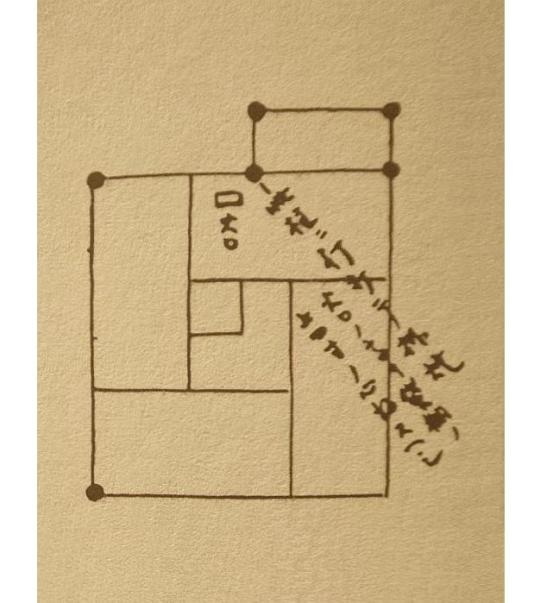
[The writing reads: written on a diagonal, kono-hashira kugi-butsu kake-tomoshibi (此柱 釘打掛灯)², hi-guchi no takasa fukuro-dana no ue yon-sun no kokoro-e-subeshi (火口ノ高サ袋棚ノ上四寸ノ心得スヘシ)³; center, hi-guchi (火口)⁴.]
〽 Go-shaku-toko no toki kaku-no-gotoki [五尺床ノ時如此]⁵.
〽 Tankei oki-kata yoshi, Shukō no shin-no-yojō-han, Engo no ō-haba wo kakerare-shi yue ikken-toko nari, tankei mo sono toki made ha okazu, shokudai nari, Jōō yojō-han, toko-naki mo ari, toko wo tsukerare-taru ha go-shaku nari [短檠置方ヨシ、珠光ノ眞ノ四疊半、圜悟ノ大幅ヲ掛ラレシ故一間床也、短檠モ其時マデハ不置、燭臺也、紹鷗ノ四疊半、床ナキモアリ、床ヲ付ラレタルハ五尺也]⁶.
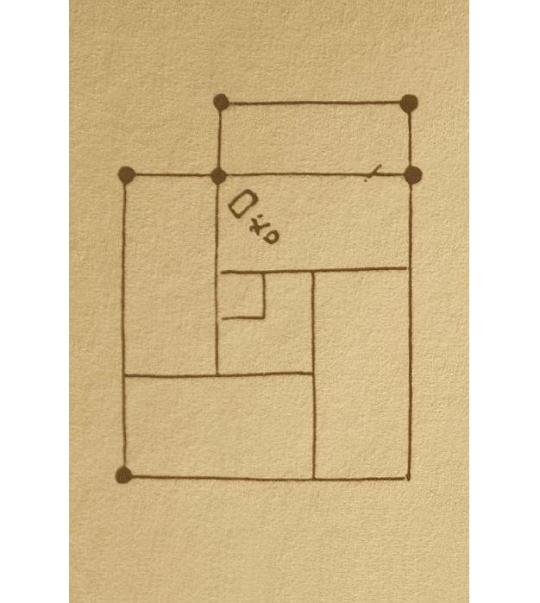
[The writing reads: hi-guchi (火口)⁷.]
〽 Ikken-toko no toki, Sōkyū kaku-no-gotoki wo okaruru, Kyū ha tsu[w]i ni ji-ka ni te, sumi-kakete okare-taru wo mizu, aru-toki, Yodo-ya no yojō-han ikken-toko ni te ari-keru ni tōdai oki-taru ni, Kyū mi-tamaite, kore ni te koso aru-beki to no tamau, shikaraba sumi-kake ha konomarezu to oboe ni, Yodo-ya ha Kyū koni no montei nari [一間床ノ時、宗及如此ヲカルヽ、休ハツヰニ自家ニテ、スミカケテヲカレタルヲ見ズ、アル時、淀屋ノ四疊半一間床ニテ有ケルニ燈臺置タルニ、休見玉テ、コレニテコソアルベキトノ玉フ、シカレバスミカケハ不被好ト覺ニ、淀屋ハ休懇意ノ門弟也]⁸.

43.1) Fuka san-jō furu-zama [深三疊古様]⁹.

[The writing reads (right to left): kono tokoro kakemono (此所カケ物)¹⁰; kono kabe chū-dan kōshi ari, mata chū-dan made ni shite, hashira nashi ni, ita no furo-saki mo ari, takasa kama no mie-kakure (此カヘ中段カウシアリ、又中段迄ニシテ柱ナシニ、板ノ風爐サキモアリ、高サ釜ノ見ヘカクレ)¹¹; isshaku go-sun ita (一尺五寸板)¹²; ro wo koko ni kirareshi ha, isshaku-yon-sun kiwamarite ato no koto nari, hajime ha ita no ue ni daisu no gotoku, kane no furo mizusashi nado gu-shite oki-shi nari (爐ヲコヽニ切ラレシハ、一尺四寸キハマリテ後ノコト也、初ハ板ノ上ニ臺子ノコトク、カネノ風爐・水サシナト具シテヲキシナリ)¹³; kake-tomoshibi koko ni (カケ灯コヽニ)¹⁴.]

43.2) Ato kaku-no-gotoki ni mo [後如此ニモ]¹⁵.
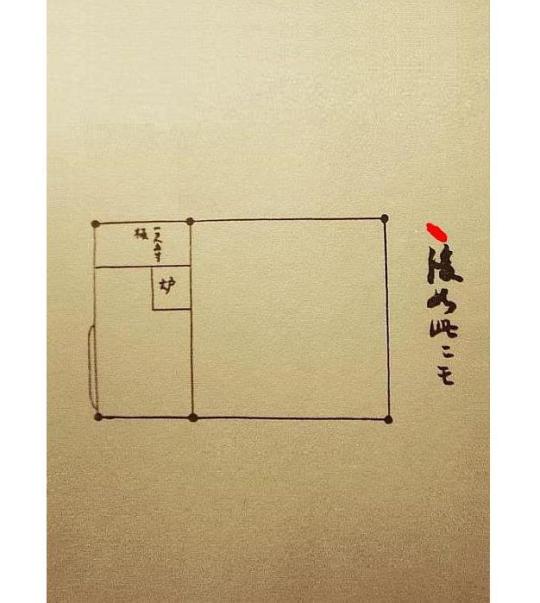
[The writing reads: isshaku go-sun ita (一尺五寸板)¹⁶; ro (炉)¹⁷.]

44.1) Naga-yojō furu-zama [長四疊古様]¹⁸.
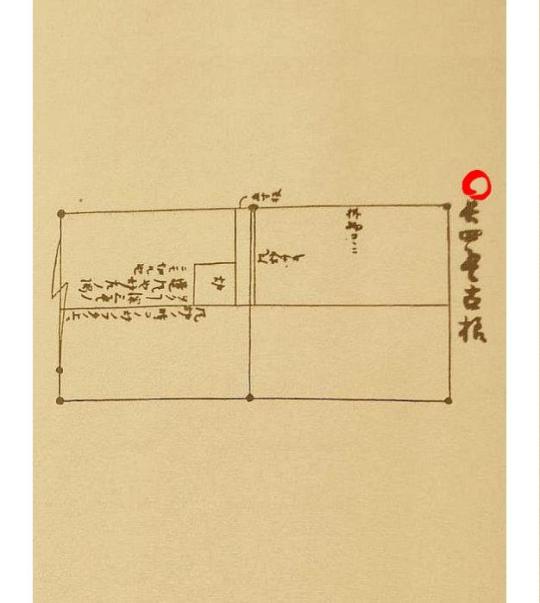
[The writing reads, from right to left: kakemono koko ni (カケ物コヽニ)¹⁹; furosaki (風炉サキ)²⁰; go-sun ita (五寸板)²¹; ro (炉)²²; furo no toki kono ro no futa no ue ni oku-koto fuka-sanjō no i-fū nari (風炉ノ時コノ炉ノフタノ上ニヲク事深三疊ノ遺風也)²³, ro hidari no sumi ni mo kiru nari (炉左ノ隅ニモ切ル也)²⁴.]

44.2) Ato kaku-no-gotoki ni mo [後如此ニモ]²⁵.
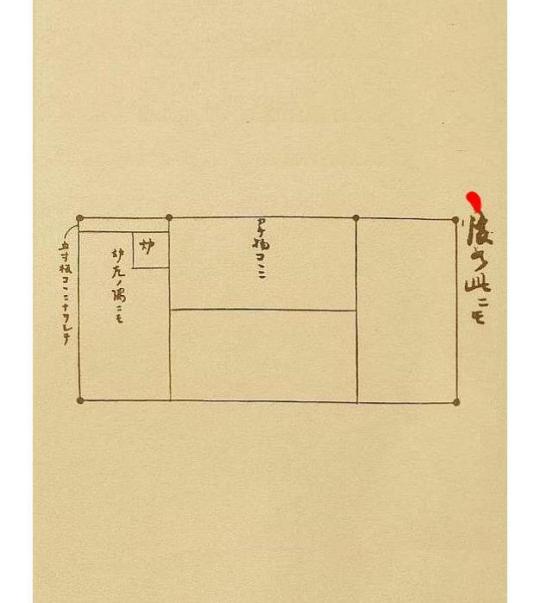
[The writing reads, from right to left: kakemono koko ni (カケ物コヽニ)²⁶; ro (炉)²⁷; ro hidari no sumi ni mo (炉左ノ隅ニモ)²⁸; go-sun-ita koko ni naoshite (五寸板コヽニホシテ)²⁹.]
_________________________
◎ This entry contains the six drawings that graphically memorialize the details of entries 39 (Lighting the 4.5-mat Room for the Shoza*), 40 (the Fuka-sanjō [深三疊] Room†), and 41 (the Naga-yojō [長四疊] Room‡). Even though these sketches have already been published in the posts to which they relate, I am repeating them here in order to maintain the series of entries as found in the Enkaku-ji manuscript version of Book Seven of the Nampō Roku.
In addition, I have included a translation of a related entry, from the Sumibiki no uchinuki-gaki・tsuika [墨引之内拔書・追加 ] (A Record of Excerpted Passages for Internal Use, Supplementary Material)**, that deals with certain points related to the three- and four-mat rooms, and their seating arrangements. This appears as an appendix, at the end of this post.
___________
*The URL for the post of entry 39 is:
https://chanoyu-to-wa.tumblr.com/post/702018933860040704/namp%C5%8D-roku-book-7-39-lighting-the-45-mat
† The URL for the post of entry 40 is:
https://chanoyu-to-wa.tumblr.com/post/702653075106742272/namp%C5%8D-roku-book-7-40-the-deep-three-mat
‡ The URL for the post of entry 41 is:
https://chanoyu-to-wa.tumblr.com/post/703015465673441280/namp%C5%8D-roku-book-7-41-the-long-four-mat-room%C2%B9
**In these translations, I usually refer to this pair of documents as the Book of Secret Teachings, and Second Book of Secret Teachings (the original Sumibiki no uchinuki-gaki only has 10 entries; most of the material that has drawn our attention is found in the much more expansive supplementary book, which contains 54 entries) for the sake of simplicity.
■ The translations found in footnotes 1 to 29 are pretty perfunctory, since everything has been discussed, in detail, in the posts (the URLs of which are given above) where these drawings first appeared. I have only provided explanations where circumstances seemed to make this appropriate.
¹Yojō-han tomoshibi no oki-dokoro [四疊半ノ置所].
This means the place to put the lamp in the 4.5-mat room.
²Kono-hashira kugi-butsu kake-tomoshibi [此柱 釘打掛灯].
“[If] a hook has been nailed into this pillar, a hanging lamp [may be hung here].”
³Hi-guchi no takasa fukuro-dana no ue yon-sun no kokoro-e-subeshi [火口ノ高サ袋棚ノ上四寸ノ心得スヘシ].
“Regarding the height of the hi-guchi, you should understand that it should be 4-sun above the fukuro-dana.”
⁴Hi-guchi [火口].
Hi-guchi refers to the place where the wicks extend above the rim of the lamp; the place where the flame is burning. The meaning here is that the hi-guchi should face toward the ro.
⁵Go-shaku-toko no toki kaku-no-gotoki [五尺床ノ時如此].
“When [the room has] a 5-shaku toko, it is like this.”
In other words, the drawing illustrates the arrangement in a room that has a 5-shaku toko.
⁶Tankei oki-kata yoshi, Shukō no shin-no-yojō-han, Engo no ō-haba wo kakerare-shi yue ikken-toko nari, tankei mo sono toki made ha okazu, shokudai nari, Jōō yojō-han, toko-naki mo ari, toko wo tsukerare-taru ha go-shaku nari [短檠置方ヨシ、珠光ノ眞ノ四疊半、圜悟ノ大幅ヲ掛ラレシ故一間床也、短檠モ其時マデハ不置、燭臺也、紹鷗ノ四疊半、床ナキモアリ、床ヲ付ラレタルハ五尺也].
“The way the tankei has been placed is suitable. In Shukō's shin [眞] 4.5-mat room, because he wanted to hang the wide scroll [that had been written by] Engo, [the room] had a 1-ken toko. Up to that time, the tankei was still not placed [in the tearoom]; [they] used a candlestick.
“Jōō also had a 4.5-mat room that did not have a toko. And when he wanted to attach a toko, it was 5-shaku [wide].”
⁷Hi-guchi [火口].
Again, the word hi-guchi indicates the orientation of the tankei. In this case, it is placed on a diagonal, so that the lamp gives light not only to the ro, but to the interior of the toko as well.
⁸Ikken-toko no toki, Sōkyū kaku-no-gotoki wo okaruru, Kyū ha tsu[w]i ni ji-ka ni te, sumi-kakete okare-taru wo mizu, aru-toki, Yodo-ya no yojō-han ikken-toko ni te ari-keru ni tōdai oki-taru ni, Kyū mi-tamaite, kore ni te koso aru-beki to no tamau, shikaraba sumi-kake ha konomarezu to oboe ni, Yodo-ya ha Kyū koni no montei nari [一間床ノ時、宗及如此ヲカルヽ、休ハツヰニ自家ニテ、スミカケテヲカレタルヲ見ズ、アル時、淀屋ノ四疊半一間床ニテ有ケルニ燈臺置タルニ、休見玉テ、コレニテコソアルベキトノ玉フ、シカレバスミカケハ不被好ト覺ニ、淀屋ハ休懇意ノ門弟也].
“When [the room] had a 1-ken toko, Sōkyū wanted to place [the tankei] like this. But [as for] Rikyū, [the tankei] was never seen to be placed so that it rested in the corner [of the mat] in his own home.
“On one occasion, in Yodo-ya’s 4.5-mat room with a 1-ken toko, the tōdai was placed out in the aforementioned way. When [Ri]kyū saw it, he declared ‘this is exactly the way it should be done!’
“In light of this, perhaps we should consider that he did not [really] like [the way Sōkyū had arranged it]. Yodo-ya [Gentō] was one of [Ri]kyū’s most intimate disciples.”
⁹Fuka san-jō furu-zama [深三疊古様].
“The old style of the deep 3-mat [room].”
¹⁰Kono tokoro kakemono [此所カケ物].
“The kakemono is [hung] in this place.”
¹¹Kono kabe chū-dan kōshi ari, mata chū-dan made ni shite, hashira nashi ni, ita no furo-saki mo ari, takasa kama no mie-kakure [此カヘ中段カウシアリ、又中段迄ニシテ柱ナシニ、板ノ風爐サキモアリ、高サ釜ノ見ヘカクレ].
“In the middle of this wall is a lattice-work. But again, with respect to this, including the making of [the lattice in] the middle, when the pillars [that would support the wall] are absent, a furosaki made from boards can also be [used].
“It should be high enough to hide the kama from view.”
¹²Isshaku go-sun ita [一尺五寸板].
“The board [measures] 1-shaku 5-sun.”
¹³Ro wo koko ni kirareshi ha, isshaku-yon-sun kiwamarite ato no koto nari, hajime ha ita no ue ni daisu no gotoku, kane no furo mizusashi nado gu-shite oki-shi nari [爐ヲコヽニ切ラレシハ、一尺四寸キハマリテ後ノコト也、初ハ板ノ上ニ臺子ノコトク、カネノ風爐・水サシナト具シテヲキシナリ].
“As for wanting to cut the ro here, this only appeared after the ro was fixed at 1-shaku 4-sun [square].
“Originally, a metal furo, mizusashi, and so on, were [all] placed on top of the board, just like [on] the daisu.”
¹⁴Kake-tomoshibi koko ni [カケ灯コヽニ].
“A hanging lamp is [suspended] here.”
¹⁵Ato kaku-no-gotoki ni mo [後如此ニモ].
“After, [the fuka-sanjō room] was also [arranged] like this.”
¹⁶Isshaku go-sun ita [一尺五寸板].
“The board [measures] 1-shaku 5-sun.”
¹⁷Ro [炉].
The ro is shown on the right. However, it was also permissible to cut it on the left side of the mat, adjoining the wall of the katte.
¹⁸Naga-yojō furu-zama [長四疊古様].
“The old style of the long 4-mat [room].”
¹⁹Kakemono koko ni [カケ物コヽニ].
“The kakemono is [hung] here.”
²⁰Furosaki [風炉サキ].
This furosaki could refer either to a free-standing screen made of two boards, or to one (or more) boards suspended between a pair of pillars. In either case, the height should be equal to that of the lid of the kama (when arranged on the furo).
²¹Go-sun ita [五寸板].
“The board [measures] 5-sun [wide].”
²²Ro [炉].
The ro is shown as being cut on the right side of the mat. While this was the orthodox position (according to the classical understanding that the fire should always be located between the part of the room where the guests were seated, and the mizusashi and chaire), it was also permitted for the ro to be cut on the left side (which corresponded with its position on the ji-ita of the daisu).
²³Furo no toki kono ro no futa no ue ni oku-koto fuka-sanjō no i-fū nari [風炉ノ時コノ炉ノフタノ上ニヲク事深三疊ノ遺風也].
“When the furo is being used, there is the case where it is placed on top of this lid of the ro. This was a practice of long standing that began with the fuka-sanjō.”
²⁴Ro hidari no sumi ni mo kiru nari [炉左ノ隅ニモ切ル也].
“The ro may also be cut in the left corner [of the mat, in front of the board].”
²⁵Ato kaku-no-gotoki ni mo [後如此ニモ].
“After, [the naga-yojō room] was also [arranged] like this.”
²⁶Kakemono koko ni [カケ物コヽニ].
“The kakemono is [hung] here.”
²⁷Ro [炉].
This was the more common location for the ro [based on the argument that the fire should be moved closer to the guests when the weather was cold].
²⁸Ro hidari no sumi ni mo [炉左ノ隅ニモ].
“The ro may also be [cut] in the left corner [of the utensil mat].”
²⁹Go-sun-ita koko ni naoshite [五寸板コヽニホシテ].
“The go-sun-ita is repositioned here.”
“Repositioned” (naoshite [直して]) because, in the original form of the room, the board appeared to be oriented between the utensil mat and the mat that was functioning as the tokonoma. According to that idea, the board should have been found on the right side of the mat. However, that is mistaken. The board should be found at the end of the utensil mat, to make it seem to be an inakama-datami.
==============================================
❖ Appendix: Entry 39 from the Second Book of Secret Teachings.
Because the deep 3-mat room was originally [just] the [enclosed] veranda of Jōō's sitting room, there was only one way [for the guests] to advance [through the room]³⁰. Later this [problem] was resolved [by changing the orientation of the mats]; but even if this gave [the guests] more freedom [to move about]³¹, it did not really solve [the problem]³². As a result, in the present day [the three-mat room] has largely been discarded³³.

० The deep three-mat room:

〽 (①) If the shōkyaku [takes his seat] here, his position will be the same as when the room has an ordinary mukō-ro³⁴.
〽 (②) If [the guests] take their seats as shown [in this drawing, with the shōkyaku seated in the spot indicated near the katte-guchi], the host will have appropriate access [to all of them]³⁵.
〽 If, during the furo season, [the utensils are arranged] only on the board, [the host] will not be able to gain access to [all of the guests]³⁶.
〽 In any case, it is appropriate for the shōkyaku to sit near the katte-guchi (as shown in this sketch), during both the sho[za], and the go[za]³⁷.

० The long four-mat room:

〽 When the host is serving the guests, there is no way for [him] to gain access to the [guest in the] last seat³⁸. Consequently, the shōkyaku should undertake to act as his intermediary, passing things along to the [person in the] last seat³⁹ -- because, otherwise, there will be no way for the host to be able to serve [that guest]⁴⁰.
[A guest who understands] such [things] is what we mean when we say that a “man of experience” enters [the tearoom]⁴¹.
_________________________
³⁰Fuka-sanjō ha Jōō i-ma no engawa naru yue, ippō agari nari [深三疊ハ紹鷗居間ノ椽カハナル故、一方アカリナリ].
Jōō i-ma no engawa [紹鷗居間の縁側]: i-ma [居間] means a living room, a residential room, or a sitting room (a room that could be used to receive guests); engawa [椽カハ = 縁側] usually means a porch or veranda, but here it seems to refer to a sort of room created by arranging mats on a veranda, which are then enclosed by banks of shōji along the exposed sides to protect them from the weather*. This space was then used as a dedicated tearoom.
Fuka-sanjō ha Jōō i-ma no engawa naru yue [深三疊は紹鷗居間の縁側なるゆえ] means “because the deep 3-mat room was originally (just) the (enclosed) veranda of Jōō's sitting room....”
Ippō agari nari [一方上がりなり] means something like “there was only one way to advance (into the room).”
In other words, due to the limited space available on the preexisting veranda, the area of the mats available for the guests to enter were limited to a single line. Thus, there would be no room for two-way traffic. Once a person moved to the end of this line of mats, and he was followed by others, he could not get out again unless the other guests left the room first.
__________
*However, according to Kotobank [コトバンク] https://kotobank.jp/, this kind of enclosed veranda only appeared during the first half of the seventeenth century (jū-shichi seiki zenhan ni fuki hanashi no irigawaen kara naibu ni torikoma reta engawa ni henka shite iru [17世紀前半に吹き放しの入側縁から内部に取り込まれた縁側に変化している]). This would make the argument that Jōō purportedly enclosed his veranda to create this kind of room an anachronism -- a concept possibly generated by the machi-shū to give historical legitimacy their 3- and 4-mat rooms.
³¹Ato ni naoshite jiyū ni shitaru jūkyo mo aredomo [後ニナホシテ自由ニシタル住居モアレドモ].
Ato ni naoshite [後に直して] means later this (problem) was resolved (by changing the orientation of the mats so that the utensil mat was perpendicular to the two mats on which the guests would sit).
Jiyū ni shitaru jūkyo mo aredomo [自由にしたる住居もあれども] means even if (this) were done so that (the guests) would be free (to move about as they wished)....
³²Jū-bun naki yue [十分ニナキユヱ].
Ju-bun ni nai yue [十分にないゆえ] means this was not enough.
In other words, while rearranging the room and so give the guests free reign to move around the two mat area was an improvement over the original form of the three-mat room, it still meant that, regardless of how the mats were arranged, one of the guests would still be sitting within the same one-mat space as the kakemono. Thus, this was not ideal.
Apparently, the argument that is being made is that, because this 3-mat area was being appended to the outward-facing side of Jōō's preexisting 4.5-mat reception room, he was thereby limited with regard to the length of the room -- which could not exceed the width of the room to which it was attached (namely 9-shaku 4-sun 5-bu, or a mat and a half).
³³Tō-sei chari-tari [當世捨リタリ].
Tō-sei [當世] means in the present day (i.e., the early Edo period, when this text was written).
Shari-tari [捨りたり]: shari [捨り = 捨離] means to abandon (specifically, all worldly desires), so here shari-tari seems to be roughly equivalent to sute-tari [捨てたり], and so means that the three-mat room had largely been relegated to the dustbin of history by the time this text was written. It was no longer used, because it could not fully free itself from the danger of inconveniencing the guests.
³⁴Koko ni shōkyaku tsugi-taraba tsune no mukō-ro no mi-gamae [コヽニ上客ツキタラバ常ノ向炉ノ身構].
Tsugi-taraba [次たらば] means to want to sit beside, will sit beside.
In other words, if the shōkyaku decides to sit in that place*, everything will be done as if they were in a 2-mat room with a mukō-ro.
__________
*This seems to mean that the shōkyaku enters the room last (so that he will take his “rightful” seat in front of the toko). Then, after he has finished inspecting the toko, he moves onto the next mat (so that the other two guests will have to move closer to the lower end, so that all three are sitting on the same mat).
³⁵Kaku-no-gotoki za-tsuki-sōraeba shu no mi-gamae hirakite yoshi [如此座着候得バ主ノ身構ヒラキテヨシ].
Kaku-no-gotoki za-tsuki-sōraeba [かくの如き座着き候えば] means if the guests all take their seats as shown (in the drawing)....
Shu no mi-gamae hirakite yoshi [主の身構開きてよし ] means that the host will have suitable access (to all of the guests); the host will be able to serve them appropriately.
³⁶Ita bakari ni te furo no toki ha hiraku-koto nashi [板斗ニテ風炉ノ時ハヒラクコトナシ].
Ita bakari ni te furo no toki [板ばかりにて風炉の時] means when, during the season of the furo, (all of the utensils) are (arranged only) on the mukō-ita [向板]*....
Hiraku-koto nashi [開くこと無し] means (the host) will not have access (to all of the guests).
This is because, when the utensils will be arranged on the board, not only are the furo and kama placed out during the shoza, but also the mizusashi, shaku-tate, koboshi, and futaoki -- just as if these things were arranged together on the o-chanoyu-dana (from which this arrangement was actually derived). As a result, the host will be unable to pass as close to the board as he could when there was nothing on it.
__________
*The large board measuring 3-shaku 1-sun 5-bu by 1-shaku 5-sun.
³⁷Shōkyaku to-kaku katte-guchi no kata ni zu no gotoku sho-go tomo ni ite yoshi [上客トカク勝手口ノ方ニ図ノコトク初後トモニ居テヨシ].
Tokaku [とかく] means anyways, in any case, at any rate.
Katte-guchi no kata ni [勝手口の方に] means in the place closest to the katte-guchi.
Zu no gotoku [図の如く] means as is show in the sketch.
Sho-go tomo ni [初後ともに] means during both the shoza and (also) the goza.
Ite yoshi [居てよし] means it is appropriate to remain (in that seat).
³⁸Shu tamai-suru toki ha matsu-za made tōru-beki michi nashi [主給スル時ハ末座マデ通ルベキ道ナシ].
Shu tamai-suru toki [主給いする時] means when the host is serving the guests -- the reference is to his serving of the kaiseki (and specifically to things like handing each guest his own tray of food, pouring sake for each of the guests, and so forth).
Matsu-za made tōrubeki michi nashi [末座まで通るべき道なし] means there is no path for (the host) to gain access to the (guest in the) last seat.
³⁹Shōkyaku tori-tsukite matsu-za [h]e yaru nari [上客取次テ末座ヘヤルナリ].
Shōkyaku tori-tsukite [上客取り次ぎて] means the shōkyaku (should) act as an intermediary; the shokyaku should pass (that thing) along.
Matsu-za [h]e yaru [末座へ遣る] means pass (it) along to (the person in) the last seat.
In other words, with respect to something like the tray of food, the shōkyaku should receive it from the host and then pass it over to the last guest; and as for the pouring of sake, the shōkyaku should request the chōshi [銚子] or tokuri [徳利] from the host, and then pour for the last guest.
⁴⁰Sa nakereba shōkyaku [h]e shu no kyuji-jika ni watasu-koto narazaru-koto nari [サナケレバ上客ヘ主ノ給仕直ニ渡スコトナラザルコトナリ].
Sa nakereba [さなければ] means otherwise.
Shōkyaku [h]e shu no kyuji-jika ni watasu-koto narazaru-koto [上客へ主の給仕直に渡すことならざること] means if the host does not pass this task over to the shōkyaku, the host will be unable to serve (the last guest).
⁴¹Kōsha no iru to iu ha kayō no koto nari [功者ノ入ルト云フハカヤウノコトナリ].
Kōsha no iru to iu ha [功者の入ると云うは] means when we speak about a man of experience entering (the tearoom)....
Kayō no koto nari [斯様のことなり] means that is what we are talking about.
0 notes
Note
HII KIRA KIRA looks at you :] persona names maybe... (feel free to choose from all games, but obviously 5 is the one I know :D)
yeye!! (nick)names from persona 5!!!
Aka, Akan, Akane, Aki, Akim, Akimi, Akimitsu, Akira, Al, Ali, Alice, Ang, Ango, An/Ann/Anne, Aoi, Ama, Amami, Amamiya, Ake, Akechi, Ara, Arai
Car, Caro, Carol, Caroli, Carolin/Carolyn, Caroline, Chi, Chiha, Chihay, Chihaya, Coach
Dem, Demi, Demiu, Demiur, Demiurge, Di, Dir/Dire, Director
En, Ena, Esc, Esca, Escar, Escargo/Escargot
Fu, Futa, Futaba, Fuji, Fujikawa
Go, Goro
Haru, Hi, Hif, Hifu, Hifumi, Has, Hase, Hasega, Hasegawa, Hi/Hii, Hiir, Hiira/Hira, Hiiragi, Hiraguchi, Hy, Hyo, Hyodo
Ichi, Ichiko, Ichiryu, Ichiryusa, Ichiryusai, Igo, Igor, Iss, Isshi, Isshiki, Ichino, Ichinose, Iwa, Iwai
Jo, Jose, Jun, Juny, Junya, Jyu, Jyun, Jul/Jule, Juli/Julie, Julia, Julian, Just, Justi, Justin, Justine
Kas, Kasu, Kasumi, Kaz, Kazu, Kazuya, Ko, Kob, Koba, Kobaya, Kobayaka, Kobayakawa, Koto, Kotone, Kumi, Kun, Kuni, Kunik, Kunika, Kunikaz, Kunikazu, Kuo, Kuon, Kiu, Kiuchi, Kita, Kitaga, Kitagawa, Kamo, Kamoshi, Kamoshida, Kawa, Kawakami, Konoe, Kage, Kageya, Kageyama, Kane, Kaneshi, Kaneshiro, Kat, Kata, Kataya, Katayama, Kabu, Kabura, Kaburagi
Lala
Mak, Mako, Makoto, Mari, Mariko, Masa, Masayo, Masayoshi, Mer, Mero, Merope, Mi, Mika, Miya, Miyako, Morg, Morga, Morgan, Morgana, Moto/Motoh, Motoha, Mune, Munehi, Munehis/Munehise, Munehisa, Mish, Mishi, Mishima, Maru, Maruki, Maki, Makigami, Mifu, Mifune, Mada, Madara, Madarame, Mon, Mont, Monta, Montag, Montagne
Nao, Naoya, Nat, Nats, Natsu/Natsuh, Natsuhi, Natsuhiko, Noge, Nii, Niiji, Niijima, Naka, Nakano, Nakanohara, Natsume
Od, Oda, Oku, Okumu, Okumura, Ohya, Owa, Owada
Pres, Presi, President
Ren, Ru, Rufe, Rufer, Ruferu, Rumi, Ry, Ryu, Ryuji
Sada, Sadayo, Sae, Sei, Seiji, Shadow, Shi, Shibu, Shibus, Shibusa, Shibusawa, Shiho, Shin, Shini, Shinichi, Shiny, Shinya, Shu, Shuz, Shuzo, Si, Siu, So, Soji, Sojiro, Soph, Sophi/Sophie/Sofi/Sofie, Sophia/Sofia, Sugi, Sugimura, Suguru, Sumi, Sumir, Sumire, Saku, Sakura, Su, Suz, Suzu, Suzui, Shira, Shirato, Shiratori, Saka, Sakamo, Sakamoto, Shido
Tae, Tak, Taku, Takuto, Tom, Tomoko, Tor, Tora, Torano, Toranosuke, Take, Takemi, Tan, Tana, Tanaka, Tsu, Tsuda, Taka, Takama, Takamaki, Togo
Ubu, Ubuka, Ubukata
Wakaba
Yu, Yuki/Yuuki, Yukimi, Yusu, Yusuke, Yuji/Yuuji, Yosh, Yoshi, Yoshida, Yoshiza, Yoshizawa
Zen, Zenki, Zenkichi
#names#nicknames#baby names#first names#persona 5#persona 5 characters#persona 5 names#name searching#name list#name blog#ask answered#character names#name help#name hoarder#names list#requested list#list of names#names from characters
8 notes
·
View notes
Text

Piala Dunia 2022: Bukayo Saka Bakal Paksa Raheem Sterling Duduk di Bangku Cadangan?
Mantan pemain timnas Inggris yang kini menjadi pundit, Joe Cole ikut berkomentar siapa yang pantas untuk tampil sebagai starter bersama The Three Lions di pertandingan pertama nanti. Menurut Cole, ada beberapa pemain yang sangat layak untuk langsung membela panji Inggris di pertandingan pertama Piala Dunia 2022.
"Meskipun saya mencintai Raheem [Sterling], dia tidak dalam kondisi prima dan Saka tengah dalam masa terbaiknya sejauh ini." kata Cole.
Joe Cole juga mengatakan kemungkinan ada empat pemain yang posisinya tidak tersentuh selama gelaran Piala Dunia 2022. Karena menurutnya, empat pemain ini sedang dalam performa impresif bersama klubnya.
"Ada empat pemain yang akan bermain reguler. Pickford, Stones, Rice, dan Kane. Anda hanya mengganti seorang Harry [Kane] saat permainan selesai." tutupnya.
#88cepat#prediksi#jadwalbola#polagacor#infoslotgacor#slotgacor#gacor#maxwin#parlay#inggris#pialadunia2022
0 notes
Text
Inggris di Piala Dunia 2022: Football Is Coming Home?
CASPO777 LINK - Timnas Inggris sudah sangat lama tak bisa menjadi juara di pentas internasional. Di Piala Dunia 2022 kali ini, bisakah the Three Lions mengakhiri puasa gelar?
Inggris terakhir kali menjadi juara pada Piala Dunia 1966 saat menjadi tuan rumah. Selepas itu, Inggris, yang disebut-sebut negara asalnya sepakbola, tak kunjung bisa menjadi juara, di Piala Eropa atau pentas dunia.

Jika merujuk dari dua event internasional terakhir, grafik Inggris sejatinya meningkat. Setelah gagal di fase gugur pada Piala Dunia 2014, Inggris mampu menjadi finalis di Piala Dunia 2018 dan kalah dalam perebutan tempat ketiga dari Belgia.
Inggris kembali mengesankan pada Piala Eropa 2020, yang berlangsung pada 2021. Tim besutan Gareth Southgate mampu menjadi finalis setelah kalah adu penalti dari Italia.
ara bersamaan performa Inggris malah hancur di UEFA Nations League.
Harry Kane dkk. finis di dasar klasemen League A Grup 3, di bawah Italia, Hongaria, dan Jerman. Hasil itu juga membuat Inggris turun level ke League B. CASPO777 APK
"Kami harus percaya kami bisa menjadi juara. Melihat timnas Inggris 10 atau 15 tahun yang lalu, kami selalu takut mengatakan target juara," kata Kane dikutip dari Sky Sports.
"Saya pikir salah satu perubahan besar yang telah kami buat dalam empat atau lima tahun terakhir bersama Southgate adalah tidak takut lagi menargetkan juara," ucap striker Tottenham Hotspur itu.
"Dengar, kami akan pergi ke Piala Dunia 2022 dengan target juara karena kami yakin kami bisa melakukannya," ucap Kane.
"Akan salah jika kami berpikir sebaliknya. Apa gunanya pergi ke Piala Dunia jika tidak percaya bahwa kami bisa membawa pulang trofi?," tutur kapten timnas Inggris itu. BANDAR CASINO
0 notes
Text
Porto B. - CONHECA PORTO SEGURO B.A
V March (36) Bizhub C360 Drivers For Windows 10 : Configuring T...
My life
Horaciat Kane Glasses/ Abuja Plane Crash Small Nickel
Libro De Matematicas 1Grado Resuelto De Secundaria...
Piante Da Interno Con Foglia Palmata - Aralia Fats...
Slim Santana / Slim Santana - Came In Prod. By: @b...
Porto B - CONHECA PORTO SEGURO B.A. (MELHOR VIDEO)...
Registrierung Corona Impfung Zurich : Registrierun...
Marcumar Ausweis Bestellen Meda / MI6-Ausweis des ...
Galaxy Anti Social Social Club Wallpaper : Anti So...
Kit Dls River Plate Personalizados / Club Atletico...
Mike Woodson / 1 951 Mike Woodson Photos And Premi...
Lowongan Kerja Medan Tanpa Ijazah / Info Lowongan ...
Prangkat Pembelajaran Agama Katolik 1 Lembar Sd / ...
Traditional Mexican Christmas Desserts : Buy Ciali...
Nasi Tim Bayi Usia 6 Bulan / Kumpulan Menu Mpasi 6...
Ecq Metro Manila : Ugik9enh4czbdm
Robin Olsen : Robin Olsen - Wikipedia
Christmas baking without nuts In a village known as Se...
Best Tomato Base Soups / Homemade Roasted Tomato B...
Oatmeal Recipes for Diabetics OATMEAL FOR DIABETS C...
Bratee : Capital Bra Eistee Bratee Im Test Teamcap...
Sehrish Tariq : The Design Of Influence How To Crush...
Osterhasen Vorlage - Schablone Fur Einen Osterhase...
Festive Pasta Salads: Betty Crocker Classic Sudde...
Rl Craft for Minecraft Bedrock / Minecraft Bedrock...
Kata Mutiara Jalaludin Rumi Tentang Istri Durhaka ...
Gudang Garam Grenjeng Bojonegoro - Pertanian - Pag...
Christmas Seafood Ideas- Christmas Seafood Ideas
Aston Villa Vs Tottenham : 12 Oszlztxlwbm
Pascal Siakam Pascal Siakam Nba Sport Raptors T...
Periodic Table and Element Structure and Structure of Element
t`ryf Tb`@ Laser Jet Pro M402N - OSSUUUUU O-U...
Kreuzstich Buchstaben Vorlagen Gratis / Kreuzstich...
Lego Ninjago Games Xbox 360 / Klimatas Siuolaikini...
1 note
·
View note